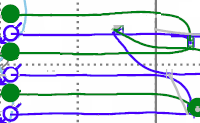What makes an AI useful for the oil and gas industry?
 The oil and gas industry is humming with
excitement about Artificial Intelligence. At Regaware, we believe that an AI
for the industry must be useful. Eight principals guide our approach for a
useful oil and gas AI.
The oil and gas industry is humming with
excitement about Artificial Intelligence. At Regaware, we believe that an AI
for the industry must be useful. Eight principals guide our approach for a
useful oil and gas AI.
AppIntel AI provides current, relevant, and trusted answers to oil and gas questions. Answers that peer into the workings of your competitors’ operations.
The earliest mention of AI in the AppIntel AI dataset is in a AER hearing in 2009.
Get those hearing documents from our self serve web portal.
Buy these submission docs now Subscribers get them for freeThe eight principals that guide our approach for a useful oil and gas AI include:
- Trust
- Very Current
- Industry specific
- Broad Appeal
- Portable access
- No Fluff
- Answer questions
Trust
AI delivered content must be very trustworthy. Oil industry puts lives at stake – there cannot be any doubt as to the trust of AI content. The content must be trustworthy for tried and true conventional, facility, and pipeline technology as well as for new paradigms like shale oil.
AppIntel AI is not like other popular large language models. Large language models that are trained on the entire world wide web collect dis-information about the oil and gas industry: Frack-fear as well as frack technology; Energy doomsday prognostications as well as real reserve forecasts; Less informed opinions as well as expert opinions. As a result, these pop AIs generate incorrect answers to simple oil and gas questions.
AppIntel AI content is vetted by a picky regulator. The regulator is a very picky adjudicator. They want all the technical details. They dig in and question everything.
Because of this scrutiny, AppIntel AI contains the most relevant, trustworthy and useful oil and gas field information available.
Current
A useful oil and gas AI must be as current as this morning. Technology changes quickly in the industry.
Unless it can deal with today’s issues, an AI that only has last year’s data is useless. AIs that take years to train are not useful in a fast paced industry like ours.
AppIntel AI sends email alerts of leading indicators several times a day on breaking news. It sends proximity alerts of competitor’s business changes within 5, 10, and 20 miles of your operation. It sends hit alerts on new field installations of your favourite technologies. It sends watch alerts on your favourite complicated AER hearings and applications.
?subject=Help me get up to speed on changes to thermal projects.&body=Help me get up to speed on changes to thermal projects.%0D%0A%0D%0AMy Name:__________ %0D%0AMy Phone Number:__________ %0D%0A%0D%0A(Or call Proven Sales at 403-803-2500.)">Contact Proven for support. We watch the leading indicators of the industry.
Industry Specific
To be useful, an oil and gas AI must be made in the industry for the industry. It will not be for general consumption or the food industry or big pharma.
AppIntel AI is made here for here. It is made using oil industry data with oil industry workers in mind.
AppIntel AI is focused on inside oil and gas industry information. All of the content has been vetted and milked for relevance and accuracy by picky regulators.
Broad Appeal
An AI must be useful for everyone in the industry including: geologists, vice presidents, drillers, frackers, petroleum engineers, facility engineers, investment bankers, lawyers, etc.
AppIntel AI has maps for geoscientists; flow diagrams for facilities engineers, recovery for petroleum engineers, as well as waste disposal, tailing ponds, environmental studies, scheme expansions, production increases, and many, many other indicators for virtually everyone in the industry.
Portable Access
A user should be able to access a useful AI anywhere, any time.
AppIntel AI allows access from phones, tablets, Chromebooks, Macs or PCs. You can even access AppIntel on Amazon fire televisions and similar entertainment devices.
No Fluff
A useful oil and gas AI doesn’t need fluff. Doesn’t matter if it sounds like Scarlett Johansen or any other movie star.
AppIntel AI doesn’t need a speaking voice. It doesn’t speak in sentences with an authoritative tone.
AppIntel’s creators are not spending time training an AI to speak in natural language, to write your reports or your company barbeque advertisements.
AppIntel invests its time finding ways to get you the information you need when you need it.
?subject=Please bring us a demo of AppIntel AI&body=Please bring us a demo of AppIntel AI.%0D%0A%0D%0AName:%0D%0ACompany:%0D%0APhone:%0D%0AInterested in:%0D%0A_ Acquisition scouting%0D%0A_ Industry leading indicators%0D%0A_ Searching for technology%0D%0A_ Alerts on new technology%0D%0A_ Quick copy of successes%0D%0A_ Competitor surveillance%0D%0A_ Existing mapping, seismic interps and facility diagrams">sales for a demo of AppIntel AI.
Answer questions
A useful oil and gas AI should answer oil and gas questions.
AppIntel AI answers questions like:
- What is the recovery factor for gas huff and puff in the Duvernay?
- How are other operators getting enough water to frack?
- How much gas supply is left in the world?
- At what azimuth direction should I drill horizontal wells? Why does it matter?
- What are current trends in LNG production?
- What is the current thinking on SAGD infills?
- How can we increase our plant H2S capacity?
- How is the shale paradigm changing our industry?
- What do we try after polymer flooding?
- What net pay maps are available for the Mannville?
- How do I win at the upcoming land sale?
- Who is doing methane and steam fences?
- What are the pitfalls of CO2 flooding?
- How do I get more out of my legacy flood?
- Which operators are conserving gas by sequestering?
- What seismic is available for SAGD plays?
- After SAGD, how are operators continuing to exploit these fields?
- What are others doing for waste disposal?
- What is the newest Montney exploitation idea?
- How are others managing tailing ponds?
- How are caverns being mined?
- How much can we increase recovery by injecting gas?
- Where has WAG worked?
- Is tight gas flooding in the Montney economic?
- How are other operators dealing with net carbon zero?
- Why are others injecting air into SAGD injectors?
- How can I get an Amazon rating for my acquisition?
- How do I get back in compliance quickly?
- How do I deal with objections to my operation?
- Current industry thinking on earthquakes from fracking?
- Will AI take my job?
- Do MEOR floods work?
- Can I do something with my old CHOPS field?
- Can I recover from legacy horizontal wells?
- Are horizontal injectors the way to go?
- How are others dealing with frack earthquakes?
- How do I stop from fracking into someone else’s well?
70,000 hours of AI training
AppIntel AI is a result of 70,000 hours of training on government application documents. AppIntel is trained to classify information by location in the basin (TWP-RNG), formation, and permeability. It also classified information by operation type: reservoir resource exploitation, natural gas plant, SAGD, CSS, exploration, waste handling, tight sands, injectants, regulatory compliance, acquisitions, and many other categories.
What other criteria should a useful oil and gas AI answer?
Tags: AI in oil and gas
 Granger Low 27 May 2024
Granger Low 27 May 2024

Astrobleme impacts deep well disposal scheme
Learn from the experience of other operators

Non-meridian thermal wells
Still drilling horizontal wells N‑S? Why?

Steam surfactant co-injection
Want to win? What is your competitive advantage?

Surprise! Sour gas production from a sweet thermal scheme
Dealing with surprises in the oil and gas industry. What to do next.

10 ways to increase production before Christmas - Infographic
For your wall to remind you

10 ways to increase production before Christmas
Each cost less than half a million

Using AI to reduce risk of oil and gas failure
How can you assess the risk without knowing the epic fails?

Artificial intelligence using vetted oil and gas information
Using anything else is dangerous

Your AI search history is being sold to your competitors
Your use of AI is not free

Smarter acquisitions
Video demo on using the KiP box for acquisitions

AI alerts increase the speed of innovation
AI launches oil and gas operators from rival wins

Elusive promise of ASP flooding
This one's ending

SAGD Blowdown Experiment
Shows his unexpected results

Selfie-mail: emails to myself
I send more emails to myself than to any other person.

Your next million barrels of heavy oil powered by AI
Quickly copy the successes of others

Shared: powerful side by side comparison of before and after polymer flood
Six fold oil production increase

Four ways your flood is crying for help
Can you hear it?

Great oil and gas operators don't just wing it — they focus
From uncertainty to control in One Day using AppIntel AI




 Calgary, Alberta, Canada
Calgary, Alberta, Canada
 Share
Share